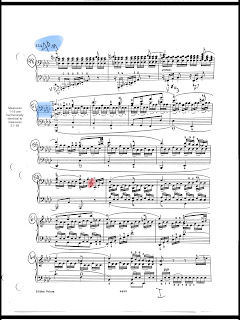The Schubert Piano Sonata D575, IV. Allegro Giusto begins in B major. The first modulation occurs in measure 14 pickups to 15, where it modulates to D major (distant key). The modulation happens by way of chromatic mediant use.
This blog was created in Spring 2020 for level-1 music theory and ear training classes at West Liberty University. We're continuing to use this blog through level 4. This is your last semester of Theory and Ear Training! Make it your best one!
FEATURED POST: recordings
Recordings for class - Fall 2021 (Th4)
Luise Reichardt, Frühlingslied Luise Reichardt, Unruhiger Schlaf Steely Dan, " The Fez " Scott Joplin, The Augustan Waltz(es) Fred...
Tuesday, September 28, 2021
Schubert Piano Sonata in B - Carmen White
The Schubert Piano Sonata D575, IV. Allegro Giusto begins in B major. The first modulation occurs in measure 14 pickups to 15, where it modulates to D major (distant key). The modulation happens by way of chromatic mediant use.
Beethoven Piano Sonata Op. 13, ii
Monday, September 27, 2021
Brahms A German Requiem i "Selig Sind"
In Brahms’s A German Requiem, i “Selig Sind,” the excerpt begins in Db Major, and cadences in measure 96 (an IAC in DbM). In measure 97, with the addition of the Cb, I hear this chord as a 7th chord, particularly a V7 chord in the key of Gb Major, which is closely related to Db Major. I think the piece stays in GbM until m. 102, when it unexpectedly goes to F Major. I think the piece stays in F Major up until the end of the excerpt (m. 110/111), which includes the cadential 6/4 going to a I chord in m 110/111.
Beethoven , Violin Concerto in D Major, op. 61, mm. 273-296 - Jenkins
The first modulation in this excerpt occurs in the second beat of measure 278. It begins in D major and modulates to A major through the use of G sharp. It is a short modulation; however, the cadenza ensures a modulation. This relationship can be distinguished as relative keys, A major being the Dominant key to D major. The piece returns to D major briefly in measure 282. Through the use of a chromatic mediant (G reaming natural in both keys), The piece appears to bein modulating to Ab major in measure 286. The piece remains in Ab major until what sounds to be a Half Cadence at the end of measure 296. Nonetheless, there are moments throughout the piece where it is hard to distinguish a "Do." For example, when listening to a recording, there is a moment when the piece sounds minor. I believed this to be chromatic tones, as there is no clear cadence to establish a modulation.
Vier Arietten und ein Duett modulation analysis - Kaylin Templeton
Beethoven’s Vier Arietten und ein Duett starts off in A major. This is the main key as it keeps coming back. The first time it modulates is in measure 6, which modulates to E major. It only lasts a few bars, as A major is prominent in measure 9. In measure 13, it modulates to C major. Measure 21 modulates to E major, then back to A major by measure 25. Measure 29 modulates to G major, and then back to A major in measure 33, and stays in that key until the end of the piece. The duet uses E major as A major’s closely related key, but G major and C major are not closely related to A major.
Sunday, September 26, 2021
Waldesgesprach Analysis - Bolyard
Saturday, September 25, 2021
Haydn String Quartet Analysis
For the piece I analyzed, Haydn, String Quartet op. 74, no. 1, ii, mm. 1-10, I only observed one modulation. The quartet began in the key of E major, and stayed in tonic throughout the first three measures. In measure 4, the predominant can be heard with the held viio7 chord, and this continues through to measure 8. In the predominant area, there is a pivot chord in measure 7 that is the I of E major and the IV of B major, and in measure 8 the piece modulates to the key of B major, continuing the IV in a different spelling. This is possible because B is a closely related key to E with it being the dominant of E major and only one sharp is added. The key of B major remains throughout the rest of the bars, with the dominant occurring in measures 9 and 10, and the final chord being the tonic. The circled notes are embellishments not meant to be notes in the chords. Something that I am not quite sure about is the presence of G and D naturals in the first chord of the B major key, the IV of the key. I am thinking this is just a stylistic choice to add even more tension to the predominant chord.
-
https://youtu.be/GS86tQDSVXM















